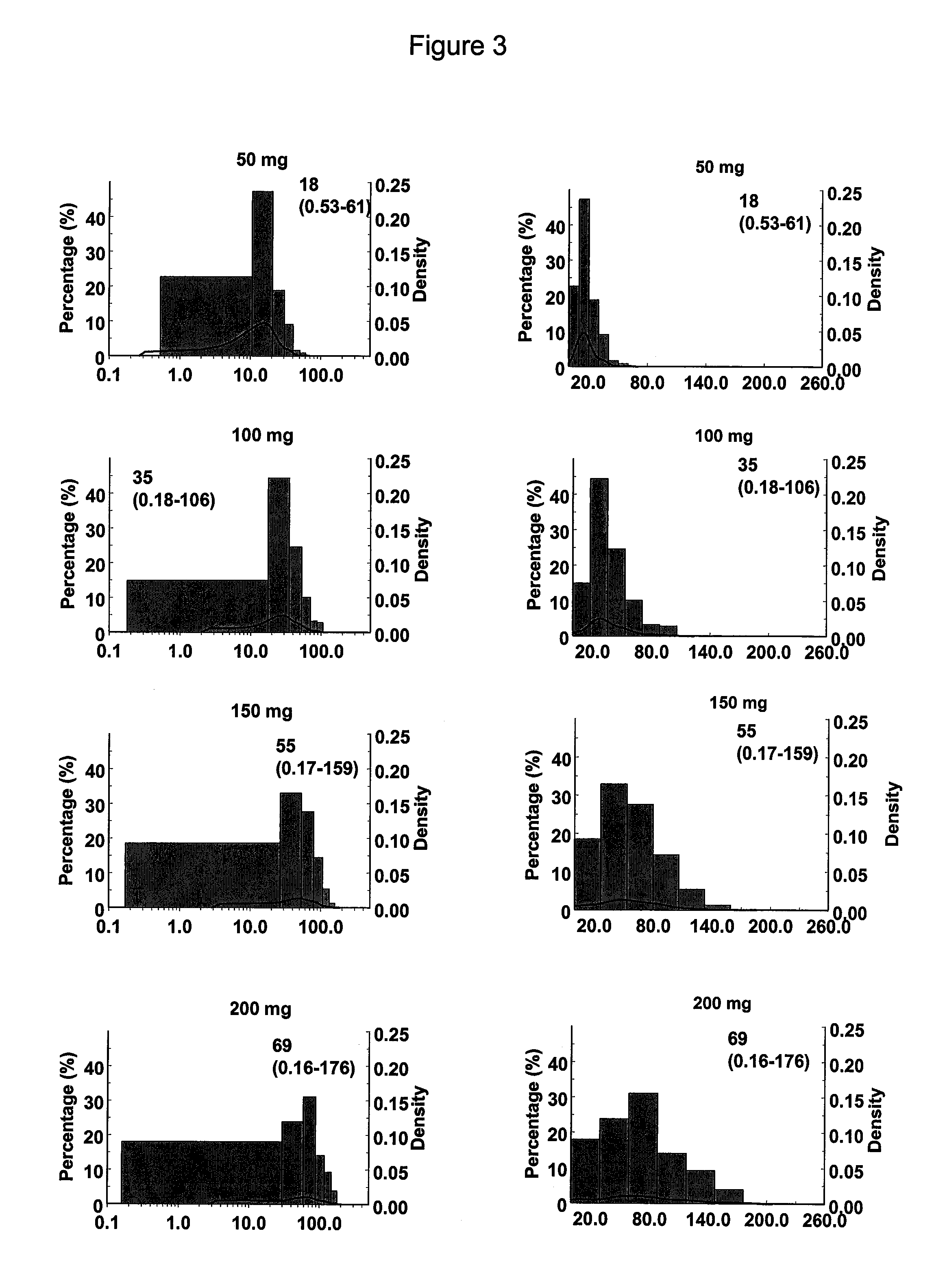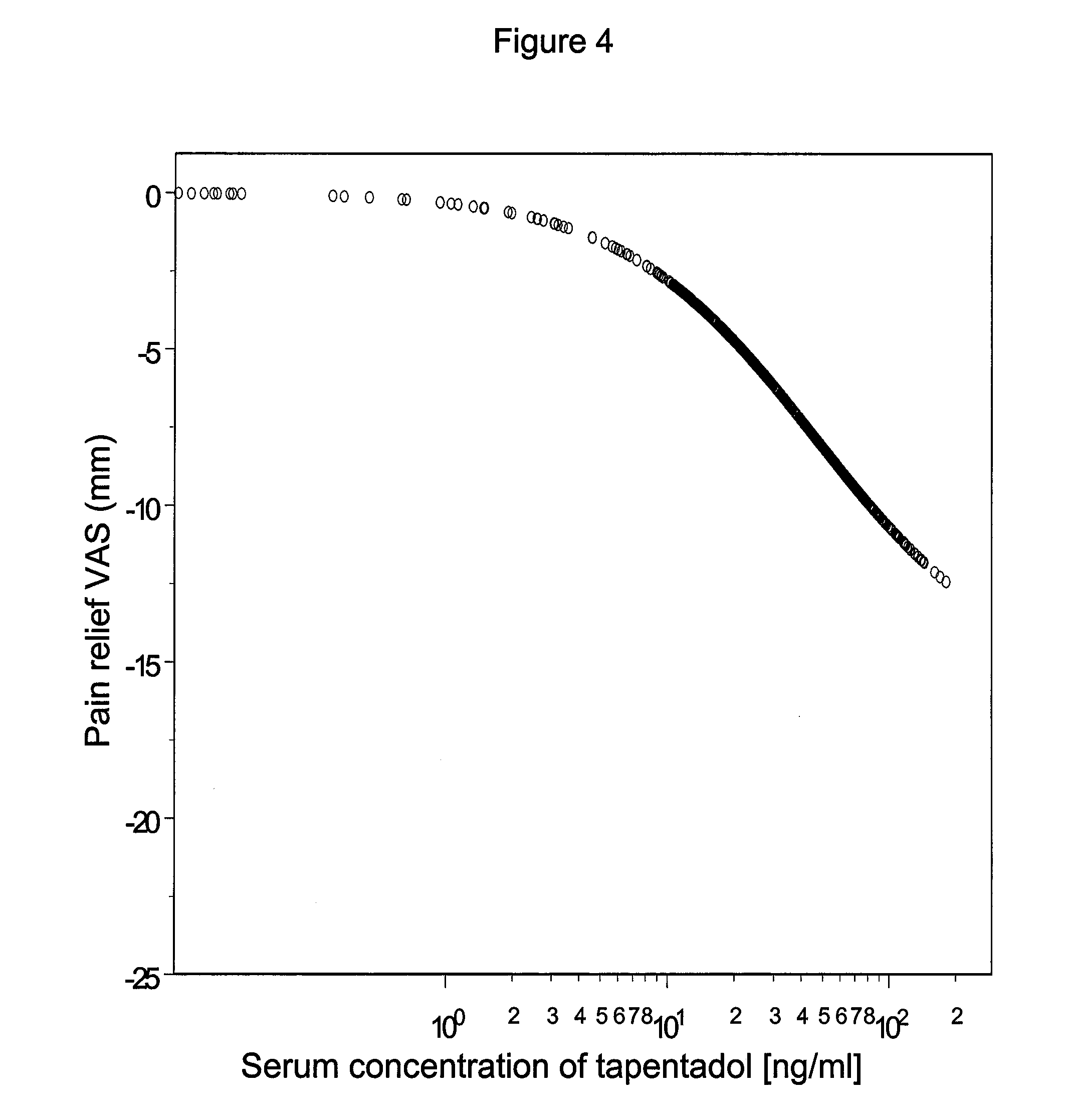Tapentadol for Treating Pain due to Osteoarthritis
a technology of osteoarthritis and tapentadol, which is applied in the direction of biocide, drug composition, nervous disorder, etc., can solve the problems of destroying the joint surface, affecting the treatment effect, so as to reduce the side effects spectrum and excellent
- Summary
- Abstract
- Description
- Claims
- Application Information
AI Technical Summary
Benefits of technology
Problems solved by technology
Method used
Image
Examples
example 1
Objective:
[0075]The efficacy and tolerability of tapentadol with prolonged release (prolonged release (PR)) and oxycodone HCl with controlled release (controlled release (CR)) were compared with a placebo in patients with moderate to severe pain due to arthrosis of the knee.
Methods (Randomised, Placebo-Controlled Double-Blind Study):
[0076]Patients (N=670) were randomly selected and treated over 28 days twice with tapentadol PR 100 mg, with tapentadol PR 200 mg, with oxycodone HCl CR 20 mg or with a placebo. The dose was titrated at the start of the treatment. The primary efficacy endpoint was the average perception of pain during the preceding 24 hours at the time of the last medical examination (final visit) based on a visual analog 100-mm sale (VAS, 0 mm=no pain, 100 mm=worst pain imaginable)).
[0077]The study consisted of a 14-day, double-blind titration phase (3 days→11 days) followed by a 14-day double-blind maintenance phase (at the highest dose of the titration scheme in each ...
example 2
Methods (90-day Phase III, Double-Blind, Active-Control, Flexible-Dose Study)
[0086]Patients (N=878) were randomly assigned in a 4:1 ratio to receive tapentadol IR (50 or 100 mg every 4-6 hours as needed; up to 600 mg / day) or oxycodone HCl IR (10 or 15 mg every 4-6 hours as needed; up to 90 mg / day). Pain intensity over the 24 hours prior to each visit was recorded from the date of the first study drug intake through the last visit using an 11-point numerical rating scale (0=“no pain,” 10 “worst possible pain”). Tolerability was assessed starting on the day of the first intake of study drug and concluded 2 days after the final study drug intake.
Results:
[0087]A total of 679 patients in the tapentadol IR group and 170 patients in the oxycodone HCl IR group were included in the efficacy and safety analyses. The pain intensity scores were similar between the groups over time. Mean baseline pain intensity scores were 7.0 for the tapentadol IR group, and 7.2 for the oxycodone HCl IR group. ...
example 3
Methods (Phase III, Double-Blind Study)
[0088]878 patients were randomly assigned to take tapentadol IR (50 or 100 mg; max, 600 mg / d) or oxycodone HCl IR (active control; 10 or 15 mg; max, 90 mg / d) every 4 to 6 hours as needed for 90 days. Treatment groups were compared with the Cochran-Mantel-Haenszel test.
Results:
[0089]Analyses included 679 and 170 patients in the tapentadol IR and oxycodone HCl IR groups, respectively. Opioid-experienced patients (taking opioids at least 5 days / week for 30 days before screening) made up 49.0% and 48.2% of patients in the tapentadol IR and oxycodone HCl IR groups, respectively. Mean pain scores decreased from baseline to study end for the tapentadol IR (7.0 to 4.9) and oxycodone HCl IR 7.2 to 5.2) groups, respectively. The most common treatment-emergent adverse events (TEAEs) were nausea, vomiting, dizziness, constipation, headache, and somnolence. Significantly (P<0.001) fewer gastrointestinal TEAEs occurred in the tapentadol IR group (nausea, 18%...
PUM
| Property | Measurement | Unit |
|---|---|---|
| concentration | aaaaa | aaaaa |
| concentration | aaaaa | aaaaa |
| concentration | aaaaa | aaaaa |
Abstract
Description
Claims
Application Information
 Login to View More
Login to View More - R&D
- Intellectual Property
- Life Sciences
- Materials
- Tech Scout
- Unparalleled Data Quality
- Higher Quality Content
- 60% Fewer Hallucinations
Browse by: Latest US Patents, China's latest patents, Technical Efficacy Thesaurus, Application Domain, Technology Topic, Popular Technical Reports.
© 2025 PatSnap. All rights reserved.Legal|Privacy policy|Modern Slavery Act Transparency Statement|Sitemap|About US| Contact US: help@patsnap.com



